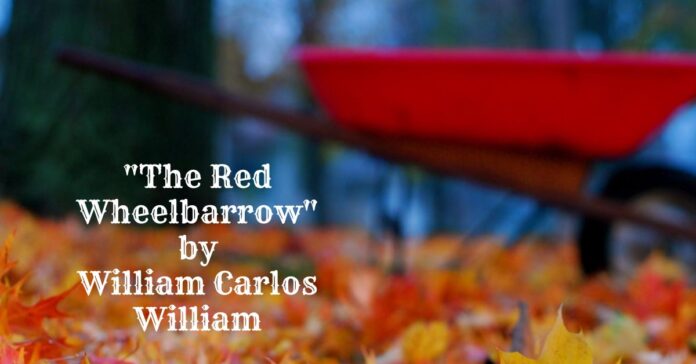Summary of the Poem “The Red Wheelbarrow”
Written by William Carlos William, a phenomenal American poet, and writer, “The Red Wheelbarrow” is a short, enigmatic poem. It consists of just sixteen words, divided into four lines. The poem gained immense popularity due to its brevity and use of imagery. The poem is often interpreted as a meditation on the nature of reality and the relationship between the material world and the individual’s subjective experience.
The poem begins with a simple statement, suggesting that much of what we understand about the world depends on our perspective and interpretation of the events and objects surrounding us. The next line states the poem’s central image: “a red wheelbarrow.” This image is highly evocative and has been the subject of much debate and interpretation.
The poem’s final two lines reinforce the theme of subjectivity and interpretation, with the phrase “glazed with rainwater” adding a layer of meaning and depth to the image of the red wheelbarrow. The rainwater is a metaphor for how our understanding of the world is shaped by our emotions and emotional responses to the things we encounter. It also suggests how the world is constantly in flux and change. Even the most seemingly mundane objects take on new meanings and significance as they are viewed through the lens of our own experiences and emotions.
To see the full poem, please click here.
Major Themes
The poem’s major themes are the importance of the ordinary, the relationship between humans and the world, and simplicity. The poem focuses on a seemingly insignificant object, “a red wheelbarrow,” and elevates it to a central role in the poem. The speaker highlights that even ordinary and mundane things can hold great significance and meaning.
The poem also speaks of the “rain” and “chickens” that depend on the red wheelbarrow, suggesting an interdependent relationship between humans and nature. The description of the wheelbarrow further reinforces this theme as “glazed with rainwater,” which suggests a close connection between the human-made object and the natural elements.
A third theme is the idea of simplicity and minimalism. The poem comprises just a few short lines and uses plain, straightforward language. This simplicity focuses the reader’s attention on the central image of the red wheelbarrow and its surroundings, emphasizing the idea that sometimes less is more.
Another theme is the power of language and poetry to convey meaning and emotion. The poem uses just a few simple words to create a vivid and evocative image, demonstrating the potential of language to convey complex ideas and emotions through imagery and metaphor.
Finally, the poem also touches on themes of memory and nostalgia. The image of the red wheelbarrow is likely to evoke memories and emotions for many readers, as it is a common and familiar object. This highlights the idea that even the most mundane and ordinary things can hold significant meaning and significance for us and can be a source of nostalgia and longing.
Poetic Elements Used in “The Red Wheelbarrow”
Although “The Red Wheelbarrow” by William Carlos Williams is a short and seemingly simple poem, it is full of poetic elements that contribute to its depth and beauty.
One of the main poetic elements in this poem is imagery. Williams uses vivid and sensory language to paint a picture of the red wheelbarrow and the white chickens surrounding it. The wheelbarrow is described as “glazed with rainwater,” which adds texture and depth to the image. The white chickens are described as “beside the white-washed walls,” which helps the reader visualize the scene.
Another poetic element in this poem is symbolism. The red wheelbarrow could be seen as a symbol for everyday objects and tasks that are often taken for granted yet are vital to our daily lives. The white chickens could symbolize the purity and simplicity of nature or perhaps the idea of innocence or new beginnings.
Repetition is another poetic element used in this poem. Williams repeats the phrase “so much depends” twice, emphasizing the importance of the objects in the scene. The repetition also adds a sense of rhythm and flow to the poem.
Finally, the poem also employs personification, as the wheelbarrow is described as “glazed” with rainwater as if it were a person with a glossy finish. This adds a touch of whimsy to the poem and gives the wheelbarrow a sense of personality.
Overall, The Red Wheelbarrow is a simple but powerful poem that uses imagery, symbolism, repetition, and personification to convey its message and create a vivid and memorable image for the reader.
Suggested Readings
What is Psychoanalytic Literary Theory?
What is Langston Hughes saying in his poem “I Too?”










